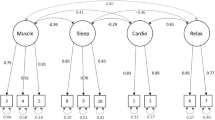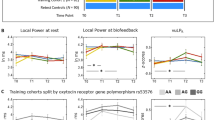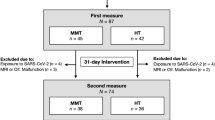Abstract
BACKGROUND: Night eating syndrome (NES) is characterized by a lack of appetite in the morning, consumption of 50% or more of daily food intake after 6:00 p.m., and difficulty falling and/or staying asleep. It has been associated with stress and with poor results at attempts to lose weight.
OBJECTIVE: The purpose of this study was to determine whether a relaxation intervention (Abbreviated Progressive Muscle Relaxation Therapy, APRT) that has been shown to significantly reduce stress levels in normal, healthy adults would also benefit an NES sample.
RESEARCH METHODS AND PROCEDURES: A total of 20 adults with NES were randomly assigned to either a relaxation training (APRT) or a Control (quietly sitting for the same amount of time) group, and all subjects attended two laboratory sessions 1 week apart. Pre- and postsession indices of stress, anxiety, relaxation, and salivary cortisol were obtained, as well as Day 1 and Day 8 indices of mood. Food diaries and hunger ratings were also obtained.
RESULTS: The results indicated that 20 min of a muscle relaxation exercise significantly reduced stress, anxiety, and salivary cortisol immediately postsession. After practicing these exercises daily for a week, subjects exhibited lowered stress, anxiety, fatigue, anger, and depression on Day 8. APRT was also associated with significantly higher a.m. and lower p.m. ratings of hunger, and a trend of both more breakfast and less night-time eating.
DISCUSSION: These data support the role of stress and anxiety in NES and suggest that practicing relaxation may be an important component of treatment for this condition.
This is a preview of subscription content, access via your institution
Access options
Subscribe to this journal
Receive 12 print issues and online access
$259.00 per year
only $21.58 per issue
Buy this article
- Purchase on Springer Link
- Instant access to full article PDF
Prices may be subject to local taxes which are calculated during checkout


Similar content being viewed by others
References
Stunkard AJ, Grace WJ, Wolff HG . The night-eating syndrome: a pattern of food intake among certain obese patients. Am J Med 1955; 19:78–86.
Rand CS, Macgregor AM, Stunkard AJ . The night-eating syndrome in the general population and among postoperative obesity surgery patients. Int J Eat Disord 1997; 22: 65–69.
Stunkard A, Berkowitz R, Wadden T, Tanrikut C, Reiss E, Young L . Binge eating disorder and the night-eating syndrome. Int J Obes Relat Metob Disord 1996; 20: 1–6.
Gluck ME, Geliebter A, Satov T . Night eating syndrome is associated with depression, low self-esteem, reduced daytime hunger, and less weight loss in obese outpatients. Obes Res 2001; 9: 264–267.
Birketvedt GS, Sundsfjord J, Florholmen JR . Hypothalamic-pituitary-adrenal axis in the night eating syndrome. Am J Physiol 2002; 282: E366–E369.
Birketvedt G, Florholmen J, Sundsfjord J, Osterud B, Dinges D, Bilker W, Stunkard A . Behavioral and neuroendocrine characteristics of the night-eating syndrome. J Am Med Assoc 1999; 282: 657–663.
Hall N, Altman F, Blumenthal S . Mind–body interactions and disease and psychoneuroimmunological aspects of health and disease. Health Dateline Press: New York, NY, 1996.
Jacobson E . Progressive relaxation. University of Chicago Press: Chicago, IL; 1938.
Bernstein DA, Borkovec TD . Progressive relaxation training. Research Press: Champagne, IL; 1973.
Masters JC, Burish TG, Hollon SD, Rimm DC . Behavior therapy: techniques and empirical findings. 3rd edn. Harcourt Brace Jovanovich: New York, NY; 1987.
Turner SM, Calhoun KS, Adams HE . Handbook of clinical behavior therapy. Wiley: New York, NY; 1992.
Carlson CR, Hoyle RH . Efficacy of abbreviated progressive muscle relaxation training: a quantitative review of behavioral medicine research. J Consult Clin Psychol 1993; 61: 1059–1067.
King NJ . Abbreviated progressive relaxation. Prog Behav Modif 1980; 3: 147–182.
Pawlow LA, Jones GE . The impact of abbreviated progressive muscle relaxation on salivary cortisol. Bio Psychol 2002; 60: 1–16.
Wadden TA, Phelan S . Behavioral assessment of the obese patient. Appendix 10.1 Section K: Eating Patterns III. In: Wadden TA, Stunkard AJ (eds) Handbook of obesity treatment. Guilford: New York, NY; 2002. pp 219–220.
Bodani UC, Edwards S . A rapid and sensitive enzyme immunoassay for the determination of saliva cortisol. Clin Chem 1999; 45(Suppl): A79.
Speilberger CD, Gorsuch RL, Lushene RE . State-trait anxiety inventory. Consulting Psychologists Press, Inc.: Palo Alto, CA; 1970.
Cohen S, Karmarck T, Mermelstein R . A global measure of perceived stress. J Health Soc Behav 1983; 24: 385–396.
Beck AT, Ward CH, Mendelson M, Mock J, Erbough J . An inventory for measuring depression. Arch Gen Psychiatry 1961; 4: 561–571.
McNair DM, Lorr M, Droppleman LF . Manual for the profile of mood states. Educational and Industrial Test Services: San Diego, LA; 1971.
Kirschbaum C, Hellhammer D . Salivary cortisol in psychobiological research: an overview. Neuropsychobiology 1989; 22: 150–169.
Streeten DH, Anderson GH, Dalakos TG, Seeley D, Mallov JS, Eusebio R, Sunderlin FS, Badawy SZ, King RB . Normal and abnormal function of the hypothalamic–pituitary–adrenocortical system in man. Endocr Rev 1984; 5: 371–394.
Cannici J, Malcolm R, Peek LA . Treatment of insomnia in cancer patients using muscle relaxation training. J Behav Ther Exp Psychiatry 1983; 14: 251–256.
Massion AO, Teas J, Hebert JR, Wertheimer MD, Kabat-Zinn J . Meditation, melatonin and breast/prostate cancer: hypothesis and preliminary data. Med Hypotheses 1995; 44: 39–46.
Hazlerigg DG . What is the role of melatonin within the anterior pituitary? J Endocrinol 2001; 170: 493–501.
Campbell DT, Stanley JC . Experimental and quasi-experimental designs for research. Rand McNally and Company: Chicago, IL; 1963.
National Institutes of Health, National Heart, Lung and Blood Institute. Clinical guidelines on the identification, evaluation, and treatment of overweight and obesity in adults—the evidence report. Obes Res 1998; 6(52): 51–210.
Author information
Authors and Affiliations
Corresponding author
Rights and permissions
About this article
Cite this article
Pawlow, L., O'Neil, P. & Malcolm, R. Night eating syndrome: effects of brief relaxation training on stress, mood, hunger, and eating patterns. Int J Obes 27, 970–978 (2003). https://doi.org/10.1038/sj.ijo.0802320
Received:
Revised:
Accepted:
Published:
Issue Date:
DOI: https://doi.org/10.1038/sj.ijo.0802320
Keywords
This article is cited by
-
Night Eating Syndrome and Its Relationship with Emotional Eating, Sleep Quality and Nutritional Status Among Adolescents’ Boys
Community Mental Health Journal (2019)
-
Severe obesity, emotions and eating habits: a case-control study
BMC Obesity (2017)
-
A Pilot Study on the Effects of Slow Paced Breathing on Current Food Craving
Applied Psychophysiology and Biofeedback (2017)



